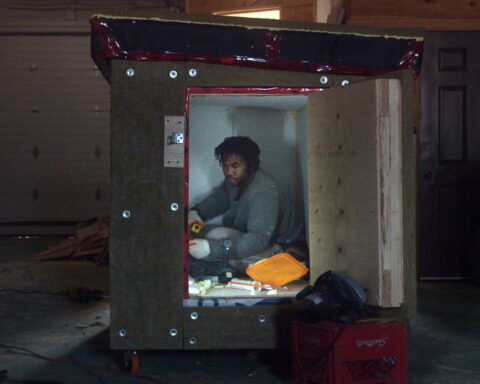Hermia & Helena
(USA/Argentina, 86 min.)
Written and directed by Matías Piñeiro
Starring: Augustina Munoz, Maria Villar, Mati Diop, Juliah Larquier
Programme: Wavelengths (North American Premiere)
Is Matías Piñeiro the director Michel Gondry was supposed to be? Possibly the only active director working in the tradition of playful innovation established by 1920s Dada and Surrealist enfants terrible like René Clair and Jean Vigo which reached its maturity in the 1960s work of Jean-Luc Godard and Jacques Rivette, Piñeiro is restlessly inventive and sophisticated. The writing, acting, editing, framing, and camera movement tread the line between calculation and spontaneity where genuine experimental vitality can happen. Similarly, the film expresses a tension between authenticity and performance without coming to definite conclusions about where its characters stand.
Piñeiro’s last two films, Viola (2012) and The Princess of France (2015), are both oblique adaptations of Shakespeare plays, and Hermia & Helena builds on this fascination. This time, we’re introduced to Carmen, an Argentine on a fellowship in New York translating A Midsummer Night’s Dream into Spanish. The meandering opening shot finds her burning a photo of a flower and meeting with Lukas, an American who works at the institute that runs the fellowship. Together, they think about what gift she’s going to give the institute and talk about her translation project. It all seems to be setting the scene for what’s to come.
The whole thing turns out to be an elaborate misdirection, though. Carmen’s fellowship is about to end, and she returns to Buenos Aires, trading places with Camila, who becomes the film’s main character. (Another misdirection: the titular Hermia and Helena are not the film’s main characters, but a couple Carmen is friends with in Buenos Aires, who bear no resemblance I can discern to their Shakespearean namesakes.) The narrative continues to proceed in these tricky, staccato jumps, blowing this way and that, as in A Midsummer Night’s Dream, by the whims of love, performance, authenticity and deceit. But rather than following a linear comic narrative, these forces become abstracted principles guiding an elliptical thematic progression, as the film leaps forwards and backwards in time to episodes centring on particular relationships, introduced by nouveau roman-style chapter headings—Carmen and Camila, Camila and Gregg, Camila and her father, and so on.
Camila, it turns out, juggles several romantic relationships, stepping away from one that was just becoming serious in Buenos Aires to pick up with an old boyfriend in New York, who she leaves just as abruptly—playfully putting him to sleep by putting her hands over his eyes—to take up with Lukas, the American from the institute. Carmen, it turns out, is also a mystery: a series of postcards tracing a road trip from Montana to New York turn out to be from Danièle, an expelled former institute fellow who had planned a rendezvous with Carmen months in advance, only to meet her replacement Camila instead. Together, they burn the postcards in the bath, Danièle remarking that, for the two of them, the objects’ transience is what makes them special.
Followed, in several instances, by series of dissolves and superimpositions of New York and Buenos Aires, the burning-photograph motif takes on greater meaning. It’s as though the cinematic image itself is a burning photograph, offering itself to us and then disappearing just as quickly. This whimsical impermanence finds a mirror image in Camila’s meeting with her father, whom she had never known, and the concurrent transition to a slower, more attentive pace. Taking on the form of a mutual interrogation as they exchange the facts of their lives, the meeting seems to suggest Camila’s desire to reconnect with some sort of permanence—she even cries afterwards, in a rare display of emotion—but the next day she’s back to her flightily charming former self.
The film ends with another charming aesthetic conceit. A door opens towards the camera, blocking its view—and the credits start rolling. Implying action beyond the camera’s view, it crystallizes the central questions the film raises about authenticity and performance—the knowable and unknowable dimensions of people—with characteristic ingenuity. Deriving ideas and characters from Shakespeare but taking off in completely new directions and refusing to resolve its conflicts, Hermia & Helena, like Piñeiro’s previous two films, is a sort of fugue on Shakespearean themes—a sort of A Midsummer Night’s Dream remix.
Hermia & Helena screens:
-Saturday, Sept. 17 at 9:30 PM at Jackman Hall
TIFF runs Sept. 8 – 18. Please visit tiff.net for more information.











